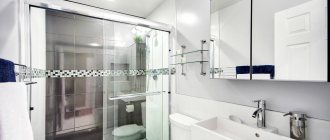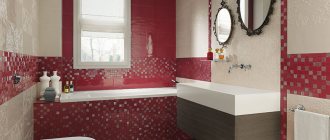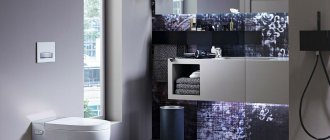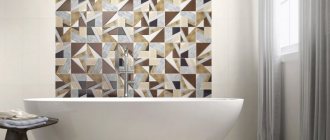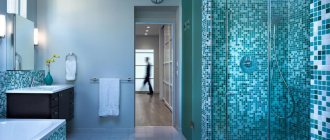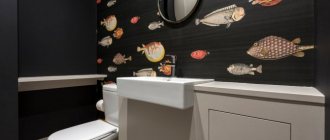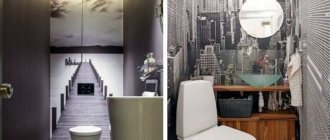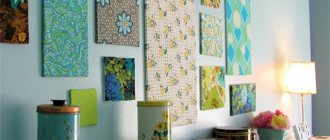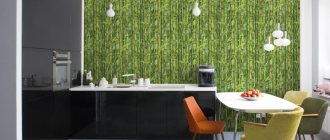Click to share
more
Toilet designs are available in a surprising number of materials. The most popular material is tile. Ceramic, porcelain and vinyl tiles are what come to mind first, and for good reason: they're arguably the most practical options.
In our article you will find many ideas for a stylish toilet area, which is usually not easy to decorate due to limited space. In addition to inspiration from the photos, in this article you will learn what to look for when completing toilet equipment. Get acquainted with the tricks of the best designers for arranging a toilet - we invite you!
Toilet design - important rules
No toilet can exist without a toilet. You can choose between a traditional and wall-hung toilet. The latest solution currently occupies a leading position in all popularity ratings. Its advantage lies primarily in the fact that it has a lightweight shape, which means it is ideal for small toilets. In addition, with such a toilet, the toilet is easier to keep clean.
The wall covering the frame can be decorated in several ways: up to the ceiling (there may be shelves inside that should be illuminated for a better effect). You can also create extra storage space for all sorts of items, such as extra toilet paper or cleaning supplies.
Remember that the toilet should be sized according to size. The appropriate size guarantees comfortable use of the toilet.
In addition to the functionality itself, it is worth paying attention to the design of the toilet seat . On the market you can choose not only different shapes (geometric, oval, stylized), but also colors. Maybe a colorful seat will match your toilet? Consider all options.
Lighting and decor
Many people think that the smaller the room, the fewer light sources are needed. This is wrong. One single lamp will not be able to cover all corners of the room. A good option is mini spotlights, which can be built into the center of the ceiling or along an extended row. Also, an LED strip for a mirror or floor lighting can become an additional stylish spotlight. Then the room will look small and cozy, and not narrow and gloomy.
Original and practical decorative elements for a small toilet can be unusual towel organizers, soap dishes, small lamps of non-standard shapes, mirrors and even plants that do not require too much light (cyperus, cactus, ficus).
more
What materials are best to use in toilet design?
Vinyl is a popular material in toilet design due to its low cost and high degree of practicality. It outperforms other popular options in safety, comfort and durability. Vinyl tiles have come a long way in aesthetic appeal and ease of installation. The material is self-adhesive and can be cut with a utility knife, which is very convenient.
Ceramic and porcelain tiles
Each interior can be decorated with taste and taste. It is enough to think through the strategy well and create functional solutions that will also be good. The right choice of materials, textures, structures and colors can create optical wonders. The ideal field for implementing this type of arrangement is toilets, which are associated with a cramped and not very comfortable interior. It's time to change that.
Ceramic tiles are becoming a popular choice among designers for a number of reasons. They are water- and stain-resistant, suitable for all practical homes, and ceramics are the perfect companion for heated floors. The overall look of tile cannot be replicated with wallpaper or paint - tile provides depth of color and stunning visual effects unlike any other decorative finish.
Whether you prefer stone or wood materials, colorful tiles or lattice-patterned squares, you'll likely find that ceramic and porcelain tile offerings are among the best for restroom design. Like vinyl, ceramic scores high in maintenance but isn't as comfortable on bare feet, but installing underfloor heating helps alleviate that issue.
If you're on a budget, ceramic tiles are probably the best solution. Cheaper tiles don't necessarily mean a compromise on style. Ceramic tiles are available in a wide range of patterns and styles to suit any look. There's always something for everyone here.
Ceramic is ideal for use in toilets and bathrooms, especially with the wide range of designs available, including those with anti-slip properties.
Ceramic is not as easy to install as vinyl, although it is a job that any DIY toilet remodeler can handle. When protected with a high quality glaze, ceramic will resist wear and scratches. Porcelain tiles are harder than clay-based tiles and can have a through-color body, which is an advantage if chipping occurs.
The durability of ceramic makes it ideal for toilets as it is scratch and abrasion resistant.
Ceramic or porcelain are great options for a room that gets a lot of moisture, such as a bathroom or wet room. In this case, the question of whether to choose porcelain or ceramic tiles comes down to what aesthetic you like; neither material's waterproof rating will let you down.
For bathroom floors, it is best to choose tiles that have high slip resistance, so they are safe when wet. Based on this characteristic, you should choose porcelain. Just check the individual tile rating before making your final decision.
also popular in toilet design . The aesthetic appeal of glass tiles is twofold: covering part of the floor with a thin layer of glass creates the illusion of depth and, if touched up, creates a beautiful stained glass effect. Installed correctly, this type of tile holds up well—just be sure to choose textured glass to prevent slipping if the tile is on the floor. Small glass tiles with more grout lines are also slip resistant.
Glass tiles have an elegant reflective surface and are available in a variety of standard colors as well as a variety of shades. Glass tiles in restroom designs are often used in mosaics or as accent walls.
Glass tiles, due to their fragility, are best suited for low-traffic walls or floors. This material is impermeable to liquids and resistant to stains, but since it is often used in smaller formats, you may spend more time cleaning the grout lines in between.
Pro tip: When purchasing ceramic, porcelain or glass tiles, make sure they are designed for use on floors. Choose ceramic tiles with a class 1 or 2 for the toilet floor. Ceramic tiles also come with a coefficient of friction (COF).
Finishing work
Floors and walls lined with ceramics look unattractive due to the empty seams. Sealing them is the finishing work. Joint jointing begins at least two days after installation: when the glue has completely dried.
The grout is diluted to the state of thick sour cream, in which a spoon can stand: a rare solution floats from the seams, a thick solution is rubbed in poorly (unevenly). Rubbing the fugue between the tiles is done with a rubber or plastic spatula. About 3 m2 of area is processed in one pass. The process is simple:
- plastic crosses are removed;
- stir the grout solution (if the fugue was purchased dry);
- use a spatula to scoop up the solution;
- the composition is applied across the seam;
- The final rubbing is carried out by passing the spatula along the seam, holding it at an angle of about 30o.
There is no need to press the spatula against the wall with force. Average effort is enough.
Traces of grout on the tiles are removed with a dry rag, since a wet rag or sponge leaves behind difficult-to-remove stains. 3-4 hours after completion of work, the filled seams are carefully inspected. In places where gaps were made or the fugue failed, the grout is rubbed in with your fingers. After this, the seams are sanded with a foam rubber sponge.
Grouting work is carried out first on the walls and then on the floor. Corners and all joints between walls and floors are filled with silicone sealant.
Stone tiles for toilet
Typically, rough and imperfect natural stone tiles, including granite, slate, limestone or travertine, can be equally at home in rustic or contemporary restrooms. Since these materials are not typically waterproof, this type requires a waterproof membrane to withstand possible moisture in the toilet. Stone tiles should be resealed at least once a year to protect the surface.
Stone tiles were once limited to entryway use only. However, in the last decade they have become popular in other rooms, including the toilet. Made from limestone, marble, granite and slate, stone tiles are available in many colors that range from cream to blue, red, green and gold. They are perfect for the toilet!
The available textures are almost as numerous and include different variations. Stone requires more maintenance than ceramic tile—regular cleaning and sealing is recommended. Additionally, stone tends to be more expensive than ceramic or porcelain wall tiles.
Choosing an interior style
The main mistakes when creating the design of a small toilet are too bright a palette of colors, an abundance of decor and a lack of overall balance. We will consider those style directions that will fit most harmoniously into a small area.
Small toilet in minimalist style
Functional simplicity and comfort are the ideal combination for a small toilet. Minimalism includes soft contrasts of light and dark shades (coffee and peach, white and gray, yellow and green), natural finishing materials (glass, wood, stone), as well as the absence of bulky decorations, which can be replaced by compact decorative lamps and panels on the ceiling.
Small toilet in classic style
The toilet should be decorated in a classic style if the overall interior design is made in such a luxurious direction. Large chandeliers, ancient statues and metal mosaics will not be relevant for a small room. It is worth giving preference to antique sink shapes, antique mirrors and marble floors.
Small toilet in Provence style
The elegance of each individual detail and light color scheme can give a small toilet additional lightness and space. It is necessary to pay attention to textiles and decor. Preference should be given to linen towels and rugs, as well as paintings and mosaics that include floral elements and discreet ornaments.
Small toilet in eco-style
The name of this design largely speaks for itself. Ecological finishing materials and textiles will highlight the uniqueness of the room, and minimalist stone souvenirs and ceramic tiles will make the atmosphere more stylish. Colors should be as consistent as possible and harmonious with each other.
Small toilet in loft style
Industrial notes in design are becoming more and more popular every year. This is not surprising, because for a modern person, not only aesthetic, but also practical aspects are important. The ideal option for a small loft-style toilet is flat facades, wooden elements, a wall-mounted toilet and brick finishing on one of the walls. It will look simple, original and comfortable.
Laminate toilet tiles
Surprisingly, laminate is a better choice for a closet than solid hardwood. Laminate flooring is resin-impregnated paper with a wood chip backing. The surface of a laminate board is actually a photograph of oak, cherry, slate, marble or any other wood or stone.
Laminate flooring can be suitable for bathrooms if you take steps to protect the wood base from moisture. The tight seams between the boards make it difficult for moisture to penetrate downwards. Laminate flooring is also easy to clean. But laminate still has a base of wood chips. If it comes into contact with moisture, it will expand and bubble, and the only way to fix this is to rip it out.
Truly waterproof laminate is an idea that has not yet been realized, although some manufacturers have tried to implement it.
Laminate tiles (most often available in plank form) are also a good choice, especially if you're remodeling a restroom and want a modern design. Like the laminate that has covered kitchen countertops for a generation or two, such tiles are now often used in vanity and bathroom designs.
If you'll be using laminate flooring, it's important to caulk gaps along the walls, around the toilet and (if it's a full bathroom) the bathtub to prevent water penetration. Another catch: Laminates don't come in the same variety of styles that you'll find with ceramic and vinyl.
Color palette
The right choice of shade for a small toilet can smooth out any imperfections, visually enlarge the space and emphasize its advantages.
White small toilet
The most optimal option for a small space, not only in terms of aesthetics, but also from the point of view of rationality. Snow-white tones can amazingly visually expand an area, making it more spacious. To prevent the room from looking too strict, you can use lamps of unusual shapes, a sink with designer patterns, or textiles with bright elements.
Green small toilet
The olive color of the walls will harmonize perfectly with yellow, pink, beige, peach, and gray. This combination of two desired shades (with a predominance of green) can create a special stylish atmosphere without the use of additional decor.
Brown small toilet
Coffee shades in toilet design always look stylish and expensive. The main thing is not to overdo it. Brown colors look great in combination with metal and wooden decorative elements, as well as with snow-white plumbing fixtures, which will visually appear even whiter. A harmonious combination of contrasts will create a special style of bathroom interior.
Blue small toilet
Sky colors can appear either cool or warm. It all depends on the desired effect. There are many options for decorating a toilet using a blue tint. This could be blue and white mosaics on the walls, delicate turquoise wallpaper or marine patterns on the floor.
Yellow small toilet
Sunny colors go well with all other bright and neutral shades. The best options are yellow with turquoise, yellow with white and yellow with olive. Plain sand motifs can be diluted with bright textiles and LED strips built into the mirror.
Wood-effect tiles in toilet design
Create a warm atmosphere with modern wood-look tiles. Ceramic and porcelain tiles that look like wood are resilient, water-resistant and have the same appearance as natural wood, making them ideal for toilets and bathrooms. Wood tiles give the bathroom the warm charm of a wood floor.
The advantage of installing wood-look porcelain tiles in toilets and bathrooms is that they are easy to clean and maintain. No sanding, re-polishing or waxing required. Wood-look tiles also offer a unique opportunity to incorporate natural textures into your bathroom that would not be possible with natural wood floors, which are susceptible to water damage.
Faux wood is the newest tile trend. These are waterproof ceramic tiles that mimic the look of wood. Engineered tiles offer the natural beauty of wood in your home, and they are as durable as ceramic tiles and more durable than hardwood. They are equally easy to maintain and come in a variety of designs.
Fire safety when finishing with tiles
Ceramic tiles are a fire-resistant material that is formed in a kiln at +1300°C, which is higher than the temperatures that occur during fires. Therefore, many architectural monuments have been preserved in different parts of the planet.
The same technologies are used in production as many centuries ago, so it retains its properties and can withstand high temperatures. Those walls that are decorated with tiles will withstand any fire. During combustion, tiles do not release harmful substances into the air.
Tile in the bathroom.
Mosaic
Mosaics are tiny tiles. They can be made from a variety of materials, including ceramic materials, porcelain, natural stone or glass. For toilet use, there is a wide range of options available, ranging from glazed or unglazed tiles.
Marble
Marble is a natural stone created from limestone that has been crushed and heated by the earth over millions of years. Exquisite and traditional, marble tiles can be fully polished and come in a variety of sizes. Marble can have patterns or veins, which will give the toilet an interesting flavor. To prevent staining and etching, the surface should be cleaned regularly with non-acidic cleaners
Marble tiles are highly durable. It is available in a wide range of colors due to variations in their mineral content. Marble tiles are also available in a variety of finishes, including polished, tumbled, matte and honed finishes. This versatility makes marble an ideal choice for any home space, including the closet.
Marble tiles also add aesthetic value to any home. It makes your home look stylish and improves its overall value. However, the downside is the cost and maintenance factor. Marble is expensive and time-consuming to maintain. In addition, it naturally absorbs moisture and is not stain resistant.
The cost of toilet tiles varies significantly depending on the material, size and design. Tile is not an expensive material, but its cost can increase if installation costs are included. Laying floor tiles is a labor-intensive process and requires the prior installation of a suitable subfloor and cement slab.
Suspended structure
A cantilever toilet is a false wall with a cistern, wires and sewer pipes hidden inside. Only the flush key and the bowl are visible, everything else is hidden. The solution with a wall-hung toilet assumes that all internal parts are reliably protected from moisture and condensation.
For many, this option seems optimal, because it looks ultra-modern and saves space. The installations are durable and practical, easy to clean and maintain. But before choosing this design method, you need to take into account the need to install an additional partition. Toilet design with installation will be quite expensive.
More often, such options are found in shopping and entertainment centers, rather than residential apartments and houses. When choosing a toilet with installation , you also need to install water filters.
Toilet design - what else is important to know?
The toilet, although an important room in every home, usually takes up a small part of it. On the other hand, small spaces create serious placement problems. This is why toilets are often not given much attention. Meanwhile, there are many functional and interesting solutions on the market for any interior and for any budget.
One of the most famous elements with which you can optically enlarge any space is mirrors. It is thanks to them that we get the effect of depth. A skillful combination of mirror surfaces can work wonders. The most popular are large-area panels glued to the wall.
No less interesting and important are the lighting and color scheme of the interior. They very often determine the attractiveness of a room and influence how you feel while staying in it. Bright colors will visually enlarge the toilet, and lighting points distributed in different places will decorate the interior. Large tile formats also benefit the interior.
Another noteworthy feature is the toilets, which can be adapted to any conditions. Popular concealed toilets allow you to free up the floor, which is also an effective means of arranging small spaces.
If you are looking to create a stylish and modern washroom design, concrete tiles are the best option. There are different sizes, colors and textures of concrete tiles. You can order custom sizes, inserts, special engraved patterns or tiles with triangular sculptures for yourself. This gives you unlimited possibilities.
It is also worth adding an element such as photo wallpaper or an interesting pattern (for example, from tiles), which will help reveal depth and bring a pleasant atmosphere to the interior. This method of arrangement can be used both on the entire wall and on part of it.
Toilet with toilet and bidet - if you have a slightly larger toilet, you can successfully fit additional elements into it. Most often this is a bidet, although a urinal can also be used.
Tile is one of the best options for a toilet, with many materials and design options available. The final choice will depend on several factors, including your budget, the square footage of the toilet you want to tile, durability, maintenance factors, the effect you want to create, and more. We hope the tips here will make things easier for you and help you create the best toilet design.
more
Requirements for bathroom cladding
Most often, bathrooms and toilet rooms are small in size, which has a positive effect on the amount of building materials required for its finishing.
But the quality of ceramic tiles for toilets must meet the specific operating conditions. The finish must be durable and easily subject to regular maintenance of its surface, since the bathroom needs an environment close to sterility.
When choosing colorful ceramic tiles, you should pay special attention to their quality. A good material for covering walls and floors in a bathroom will help you save not only on quick installation, but also on long-term use.
